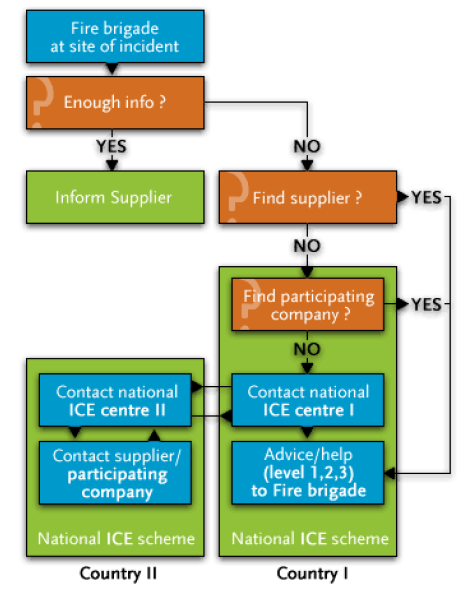ICE
About ICE
Chemical companies that practice Responsible Care® make every effort to transport goods to and from their manufacturing sites and storage locations safely and in full accordance with relevant regulations and codes of practice. In the event of an incident, they commit to provide information, practical help and, if necessary and doable, appropriate equipment to the competent authorities in charge on the emergency response to minimise any adverse effects of the incident. They have set up the ICE (Intervention in Chemical transport Emergencies) scheme to achieve this goal.
Status type
ICE is a co-operative network of national centres in European countries that participate in the scheme on a voluntary basis. It is coordinated by Cefic. In each country where a national scheme has been established, ICE seeks to create a framework for providing assistance in an effective way. It is normally opened to all manufacturers and distributors of chemical products, and administered by the national chemical industry federation which keeps a register of participating members and arranges for financial contribution.
Obligations/responsabilities
ICE seeks to create a framework for providing assistance in an effective way:
(1) by making use of the emergency response schemes of
individual chemical companies;
(2) by building on existing emergency response schemes, either local, regional or product-related (chlorine, isocyanates, ethylene oxide, etc.);
(3) by co-operating with national authorities through national chemical federations; and
(4) by promoting mutual assistance within the chemical industry.
Participation in the national ICE schemes is voluntary. To provide relevant information to the authorities in charge of the emergency response, responders in national ICE centres or in companies must meet a number of minimum requirements, either by experience or by training. These requirements have been agreed within the chemical industry and are described in a Cefic publication (see Resources /Sources of information).
Before providing assistance or advice in incidents involving their own products, chemical companies should confirm with their insurers that their policies cover any potential claims that may arise from such involvement. Companies which may be involved in giving assistance or advice relating to other manufacturers' products should notify their insurers specifically of this fact and obtain confirmation that their general
public liability policy will provide cover for these activities.
The ultimate responsibility for any intervention at the scene of an incident remains with the competent authorities in charge of the emergency response.
Role and/or Services
National ICE schemes apply to distribution incidents (i.e. those that occur outside the manufacturing fences).
For maritime incidents, Cefic, Cedre and EMSA have created the MAR-ICE network in order to provide information and expert advice on chemicals involved in maritime emergencies. MAR-ICE offers remote product and incident-specific information and advice within 1 hour of the request, and more detailed information shortly thereafter. This service is available 24 hours a day /7 days a week via a dedicated contact point at Cedre that is accessible by the relevant national maritime administrations. To connect to EMSA website, click here.
For on-land incidents, ICE assistance is provided by chemical companies. Depending on their capabilities and resources, they can offer three levels of intervention:
Level 1 - remote product information and general advice by telephone or fax;
Level 2 - advice from a company expert at the scene of the incident;
Level 3 - assistance with personnel/equipment at the scene of the incident. Such a commitment applies firstly to products manufactured by the company itself and is normally incorporated into the company's own distribution emergency response scheme.
If the product supplier is not known or cannot be contacted, certain companies may offer assistance on the basis of a prior arrangement with the national ICE scheme. However, in such a case, Level 2 and Level 3 interventions shall not be carried out at the expense of the safety of their own facilities.
The key document in the protocol between the competent national authorities and the chemical industry (represented by the national chemical federation) is the list of participating companies. This document provides contact details of each participant such as address, telephone and fax number, range of products (hazardous products are identified by the four-digit UN number), time availability, intervention equipment and area of intervention (if limited). It normally includes a map, showing the location of the participating companies so that the competent authorities can contact the site nearest to the transport incident.
Resources
The members of the ICE network are BELINTRA (Belgium), CERET (Spain), CHEMIEFACHBERATUNG (Switzerland), CHEMSAFE
(UK), DCRM (The Netherlands), DINS (Slovakia), FINTERC (Finland), KEMIAKUTEN (Sweden), PIBF-RVK (Denmark), RVK (Norway),
SET (Italy), SPOT (Poland), TRANSAID (France), TRINS (Czechia), TUIS (Austria /Germany), VERIK (Hungary).
The national centres are manned 24 hours a day by at least one person who, in addition to the local language(s), can also speak English to
facilitate communication with the other national centres.
Sources of information
Safety Data Sheets (SDS) are the main source of information. Participating companies therefore ensure that SDS for their own products are
accessible at all times at the locations identified as company contacts in the national ICE scheme. To provide initial advice, the national ICE
centres have a series of reference books or databases or may have access to a set of SDS.
Cefic has produced a guideline on "Distribution Emergency Response - Guidelines for use by the chemical industry" (1993). EMSA has produced a brochure on MAR-ICE network.
Procedure
The national ICE centre is the focal point of the scheme for the authorities in charge of the emergency response to on-land transport incidents.
They can call it when:
(1) the supplier cannot be contacted;
(2) an incident happens to international movements necessitating coordination with other countries;
(3) mutual assistance needs to be mobilised within the national ICE scheme; and
(4) the product or the producing company cannot be readily identified.
When called, the national ICE centre provides, in the local language, initial telephone advice for the immediate control of the incident. It promptly alerts the producing company, obtains further information (possibly via other national ICE centres) or mobilises mutual assistance. To do this, the centre has at its disposal appropriate communication equipment, a library of reference books or databases and up-to-date lists of telephone and fax numbers for contacts within the chemical industry.
The following chart illustrates the typical flow of response in on-land transport emergencies.
However, each country can adapt the operation of a national ICE scheme according to its own specific needs and practices already in place.

Conditions
Level 1 information is provided free of charge by the national centres participating in ICE.
Costs incurred for Levels 2 and 3 interventions are reimbursable.
Contact
|
Address CEFICAVENUE E. VAN NIEUWENHUYSE 4 B-1160 BRUSSELS BELGIUM
Website: www.ice-chem.net |
Telephone: +32 2 676 73 78 Fax: +32 2 676 73 31 Email: fle@cefic.be |


